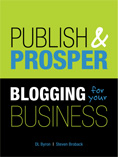Attensa
posted by DL Byron on June 12, 2006
One of our new clients is Attensa. I met them during the Six Apart Attensa Blogging for Business Seminars, we talked a lot in San Francisco and New York, and started working with them this week on their brand, blogging, and marketing. As I said, “we’re going to make sense of Attensa,” a smart company that’s developing business class RSS.
Comments (2)
other posts tagged:

Comments
Jun 14 | Kare Anderson said:
re “business class RSS”, this new finding may be of interest, from Tobi Elkin at “Just an Online Minute” today:\Will RSS eat e-mail marketing’s lunch? It’s a provocative topic and one, by the way, that OMMA magazine takes up in a feature package in the July issue—which we’re producing even as I write this column.
In any event, the Nielsen Norman Group has a new report out on the subject. The report examines RSS feeds from mainstream users’ point of view and compares them to e-mail newsletters to find that businesses forge closer relationships with customers through e-newsletters than through RSS feeds. Surprised?
We’re not. E-mail newsletters have become warm and familiar forms of communication, landing in our boxes with precision and regularity—at least when there are no technical or server issues. When the content and headlines are well-crafted, e-mail newsletters are artful creations. They can even be personalized to an extent. They serve niche audiences. They foster loyalty. (Admission: you are reading the Minute in the form of an e-mail newsletter, but also can access it as a http://blogs.mediapost.com/blog. And MediaPost’s core business is e-mail newsletters).
The Nielsen Norman report indicates RSS feeds aren’t substitutes for e-mail newsletters— and we tend to agree. The report goes on to elaborate that the fact that RSS feeds are immune to spam filters that often plague e-mail newsletters, doesn’t make them a better distribution medium for marketing communications. RSS feeds can be cold and don’t build relationships with customers as newsletters do.
Nielsen Norman Group researchers found that people today are extremely quick when processing their inbox and reading newsletters. The average time allocated to a newsletter after opening it is just 51 seconds. The predominant behavior is to scan the text—and get this, the report finds that only 19 percent of newsletters are being read fully. Eyetracking observations of users reading RSS news feeds showed that people scan the headlines and blurbs in feeds even more ruthlessly than they scan newsletters. When a message appears in an RSS newsreader, it has a very small footprint that competes for attention with a flood of headlines from other sites, according to Jakob Nielsen, co-founder and principal of Nielsen Norman Group. “Newsletters are a much more powerful medium than RSS feeds, and I would not be surprised if it turns out that companies make 10 times as much money from each newsletter subscriber,” Nielsen says in a statement. Recommendations for successful e-mail newsletters include:
—Avoid the spam filter by making it easy for people to unsubscribe to newsletters they no longer wish to receive. In its first e-mail usability study, Nielsen Norman Group observed that it took people an average of 3.5 minutes to unsubscribe from an e-mail newsletter. Now, it takes 1.38 minutes. When people can easily unsubscribe to a newsletter, they are less likely to resort to using a spam-blocking feature, which can cause legitimate newsletters to get blacklisted.
—Design newsletters to facilitate scanning. Today, skimming is reading. Designing for users who skim rather than read is essential for a newsletter’s survival.
Competition for consumer attention and loyalty is fierce, as we know here at MediaPost. We’re all swamped with information, awash with content. Flooded. We should all be respectful of what we send.
Jun 14 | -b- said:
You’re assuming the Nielsen Norman group has some cred. And is this your comment or column?